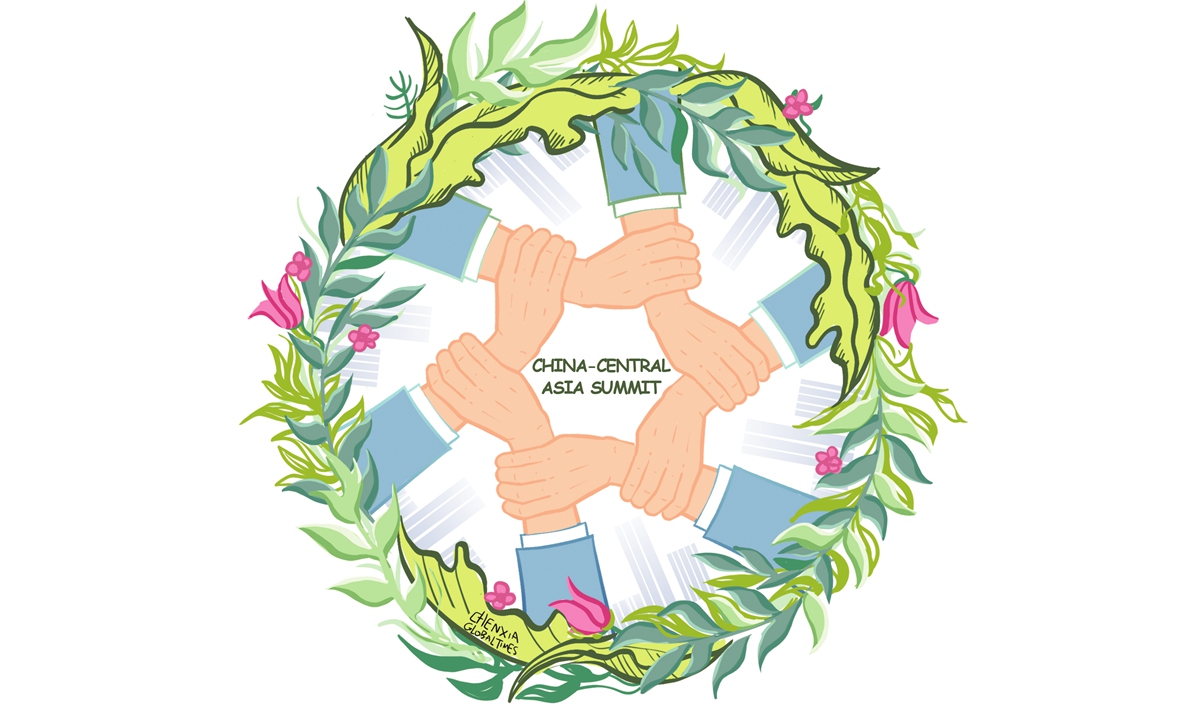On Friday, Chinese President Xi Jinping and the heads of five Central Asian countries planted six pomegranate trees after the China-Central Asia Summit. This symbolizes close solidarity and cooperation between the two sides and reflects the expectations of a better future for China-Central Asia relations. The vibrant China-Central Asia cooperation is setting off rapidly once again from the starting point of the ancient Silk Road.
From any perspective, the first China-Central Asia Summit is a “new historic milestone.” During the event, China and the five Central Asian countries signed seven bilateral and multilateral documents, including the Xi’an Declaration of the China-Central Asia Summit and the List of Outcomes of the China-Central Asia Summit. They also signed more than 100 cooperation agreements in various fields.
The summit has been fruitful, with substantial content and unprecedented influence, which will obviously promote peace and stability in the region and the world. At the same time, it is a new paradigm of solidarity and self-improvement for developing countries, and its attraction will prove strong for most developing countries in the world.
In his keynote speech at the summit, Xi put forward four visions of what kind of Central Asia the world needs, four principles for building a China-Central Asia community with a shared future, and eight proposals for developing bilateral cooperation. This is also the first time since the new era that China’s top leader has completely, intensively and systematically elaborated his foreign policy on Central Asia to the international community.
It is easy to see that the consistent philosophy of China’s foreign policy has been to achieve common development and prosperity through unity and industriousness based on the premise of high respect for each other’s sovereignty, independence, territorial integrity and national dignity. Xi’s speech was highly endorsed and received a warm response from the heads of Central Asian countries, illustrating that this summit is a mutually beneficial and win-win event.
What has caused the strongest resonance during the summit is “common destiny.” The building of a China-Central Asia community with a shared future was formally written in the Xi’an Declaration. China has also announced building a community with a shared future with five Central Asian countries at the bilateral level, which is the first time that the concept of a community with a shared future has been fully implemented at the multilateral and bilateral levels in the region.
The summit was able to establish an extensive and pragmatic series of programs and action plans, and with its solid operability, this has been unanimously accepted and recognized by all parties. This is ultimately because of the strong consensus of “sharing a common destiny.” The concept of a community with a shared future brings together these countries with different fundamental national conditions and provides a lasting and stable guarantee for their cooperation. This is what truly like-minded partners look like.
Some analysts believe that almost all the cooperation between China and Central Asian countries is based on regional mutual benefits rather than zero-sum games, which is a major reason behind the fruitful outcomes. The Central Asian region itself is a late bloomer in terms of globalization and regional integration. Moreover, it has long suffered from foreign intervention, such as “color revolutions.” What it needs most are partners who promote cooperation without selfish motives. China genuinely seeks development and cooperation and respects regional countries’ sovereign status and autonomous integration processes. This has already been proven through China’s collaborations with other countries and regions.
As Xi stated in his keynote speech, the world needs a stable, prosperous, harmonious, and interconnected Central Asia, and China will be its strongest supporter. Some foreign media outlets falsely claimed that the summit “reflected Beijing’s efforts to develop trade and security networks centered on China.” If there is any center, it is a trade and security network centered around common development and universal security. If we have to describe the relationship between China and Central Asian countries, an apt and vivid metaphor would be the six countries are united closely like pomegranate seeds.
Particularly, Central Asian countries are landlocked, which used to be one of the biggest constraints to their economic development. However, through cooperation with China, this geographical disadvantage has been transformed into a golden gateway connecting Europe and East Asia, turning their weakness into an advantage.
It is worth emphasizing that this summit has laid the foundation and comprehensive framework for China-Central Asia mechanisms, marking a new, open-ended starting point. China’s cooperation with any country is not exclusive. We hope that local prosperity and development can be promoted in Central Asia through the mechanism and that the tide of development can lift up neighboring countries.
We welcome the participation of countries that have suffered from conflict, countries aspiring for national rejuvenation, and countries pursuing modernization. We also welcome the involvement of Russia, European countries, and even the US. In fact, in recent years, there has been increasing cooperation between China and Russia in the Central Asian region, which has become a trend and effectively debunked malicious instigations by the West claiming that “China and Russia are competing for spheres of influence.”
To reiterate, as long as an initiative genuinely benefits regional stability and development and contributes to common prosperity in the region, China is willing to support it. We uphold the same set of values everywhere, be it Central Asia or any other part of the world. We are crafting a new path for peace and the development of humanity. The experience of the China-Central Asia community with a shared future in achieving universal security and common development serves as a model and inspiration for the entire world.

